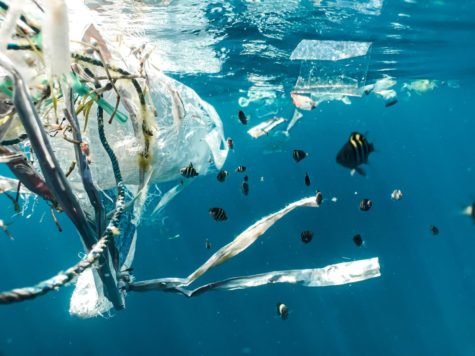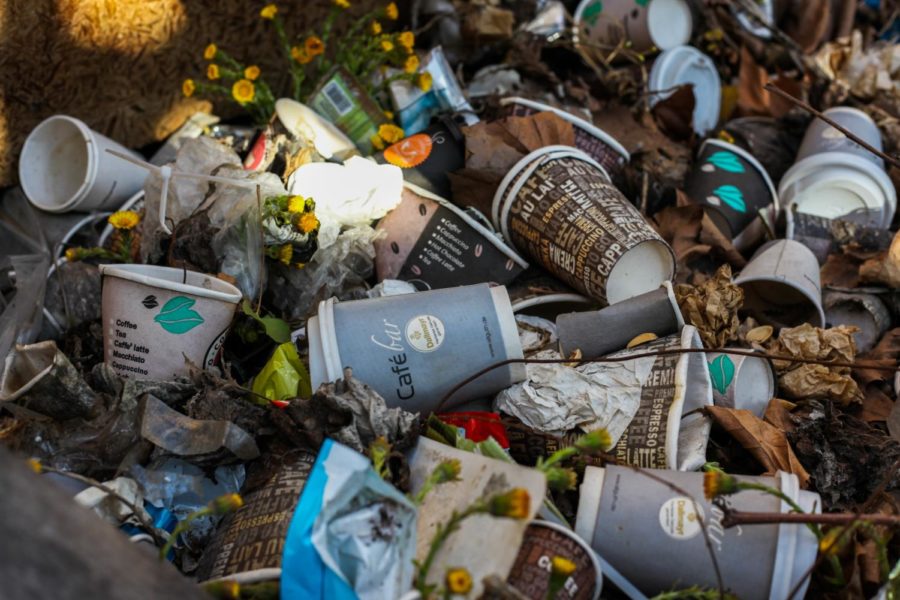You Are Throwing Away Your Future: The Effects of a Throwaway Society
As our society has advanced, our production has significantly outpaced our sustainability. How has this impacted us, exactly?
Throwaway culture is contributing to an unsustainable impact upon the environment.
Society is progressing at an amazing rate. Just in the past century, Wilbur and Orville Wright’s first airplane turned into Lockheed Martin’s F-22 Raptor. John W. Mauchly and J. Presper Eckert’s Electrical Numerical Integrator and Calculator (ENIAC) became the Apple iPhone and multiprocessor Macintosh, while the Benz Patent Motor Car paved the way for the Tesla Model S.
With all this progress, however, comes grave consequences; in the past few years, we have experienced some of the largest changes in the global average temperature.
These environmental issues can be attributed to the creation of what is known as the throwaway society, where the production of single-use items and the chasing of fads outgrows the production of sustainable. This results in major problems such as melting polar caps, the polluting of our oceans, and the global waste of electricity. So let us talk about the aspects of throwaway culture, and what we can do to help fix it.
Plastic: Production Waste
The use of plastic has been historically a major point of fixation for politicians and environmental groups. Everything has to be packaged in some way — our groceries need bags, our drinks need bottles, and our food needs wrappers. Every fast food place needs cheap, simple-to-dispose utensils like straws and forks. And for every single convoy of these items, we are going to use even more plastic to package and carry them.
The problem with this is that single-use plastics such as wrappers and straws cannot be recycled. In fact, out of the 380 million tons of plastic produced each year worldwide, 150 million tons is unrecyclable. As a result, pollution on a massive scale occurs as the plastic is dumped into landfills or the ocean.

One major step states have taken is the banning of plastic bags and limitations of plastic straw use. Already, California, Connecticut, Delaware, Hawaii, Maine, New York, Oregon and Vermont have all implemented some legislation that restricts the use of single-use plastic bags. However, a major push should be made to transform this into national legislation since single-use plastics across the U.S. results in large amounts of ocean pollution and animal death.
When asked about the problem, students at Bronx Science generally support a plastic ban, with Ellena Wang ’23 stating, “I think we need to expand them. Fish and other marine animals can consume plastics, causing injury to them and infiltrating the human food chain.”
Aside from major policy changes, there are also many small day-to-day changes you can make to decrease your dependency on single-use plastics. You can start using reusable, washable, bags for your groceries, which can help reduce the amount of paper bags used in grocery packaging. You can also start purchasing non-perishable items, in bulk if possible, which can both save you money in the long run as well as decrease the amount of plastic used for packaging.
Food for Flames: Food Waste
A throwaway society is primarily associated with consumer items like clothing and gadgets; however, food waste is just as prevalent and harmful. This can range from supermarkets throwing out unappealing or ugly foods, or throwing away leftovers at home, all the way to crops lost from farming. And despite its lack of notoriety, it is a major problem. According to the USDA, in the U.S., food waste is estimated to be about 30–40 percent of the total food supply, and back in 2010, this corresponded to nearly 133 billion pounds and $161 billion worth of food being thrown away as excess.
Although many companies already employ a variety of ways to solve the food waste crisis, such as donating these unappealing fruits to shelters or turning them into other packaged products such as juice and canned fruits, there are still many more steps we should take in our daily lives to decrease food waste.
One way of decreasing food waste is by purchasing perishable foods and groceries only when needed. Many people have a habit of making a grocery run once a week or twice a week, and often over-purchase groceries that eventually rot and get thrown away. If you instead purchase food as you need it, it can often prevent food getting thrown out as a result of spoilage.
But what happens when you do have leftovers? Well, if it is still edible, the best option would be to pack it for lunch tomorrow; but if it is not, you can start a compost bin and use your food waste to make fertilizer as a means of reducing waste and preventing the food from being placed in a landfill.
You Got Junk!: Data and E-Waste
Unlike traditional waste, digital waste is not something we can really see or do something about, but is rather a side effect of the internet. With every new e-mail account you make, every comment you leave, and every word you type, you create data, a sort of digital footprint. And as you create more and more data, much of your digital footprint eventually becomes digital waste, all of which increases your carbon footprint.
Take e-mails for example. Digital safety company McAfee reported back in 2009 that the electricity needed to transmit the trillions of spam e-mails sent annually is equal to the amount required to power over two million homes in the United States, while emitting more greenhouse gas than over three million cars.
Now, while three trillion e-mails may sound like a lot, it really is not. Data collected from students at Bronx Science show that, on average, a student has about 4,000 e-mails in their inbox. This roughly translates to ten million e-mails in the entire student population of Bronx Science. And although that is only a drop in the bucket in comparison to the trillions of e-mails sent worldwide, ten million e-mails is still a large chunk of data that remains as waste that can be easily cleared.
To fix this, you just need to be more wary of how you use the internet and store data. Regularly clean out your e-mail accounts by deleting unwanted and unnecessary e-mails, declutter your drives, and even limit the amount of computer usage to decrease power consumption.
Built to the Bin: Planned Obsolescence
Planned Obsolescence is a catch-all term for equipment or technology that was designed with the purpose of becoming obsolete after a period of time. This can mean making items that are unable to be repaired or too hard to be replaced or limiting the amount of updates the device may receive, both of which usually results in a limited device lifespan and often greater profits.
A great example of this is the lightbulb. During the 1900s, groups like the Phoebus Cartel, an oligopoly made up of companies like Phillips, Osram, and General Electrics infamously worked to standardize the life expectancy of lightbulbs to 1,000 hours, and raised prices without fear of competition. This resulted in more light bulb sales, but also more light bulbs ending up in landfills.
This remains a major problem for many countries, but particularly in the United States, as currently, there are no national laws that prohibit Planned Obsolesce in the United States, nor are there any durability mandates currently in place. This often results in companies making items that are limited in support and spare parts, forcing consumers to replace their devices entirely after a short period of time.
Currently, activists such as Linus Sebastian of Linus TechTips and Louis Rossman are all fighting for the right to repair, a type of legislation that would force companies to provide publicly accessible parts and information that would allow ordinary consumers and third parties to repair devices. The right to repair would make maintaining products like phone batteries and screens much easier, thereby helping extend the longevity of these technologies and combating planned obsolescence
The legislation can also help solve the growing problem of electronic waste as well, by keeping current electronics active. According to the Global E-waste Monitor, in 2020, out of 53.6 million tonnes of e-waste generated globally in 2019, only 17.4 percent was officially registered for collection and recycling. Researchers also expect annually generated e-waste to reach 74.7 million tonnes by 2030.
Another solution many countries have taken is by creating a reparability index, where the degree to which an item can be repaired and the accessibility of those repairs are placed in view. This gives consumers a preemptive warning about the reparability of items and often forces companies to improve the durability of the items due to the fear of lowered sales.
It is important that we quickly take action against the impending waste epidemic. And part of that action will mean us cutting down on our daily conveniences and living differently. But that, at least in my opinion, is a much better option than eventually creating a planet that is not hospitable at all.
It is important that we quickly take action against the impending waste epidemic. And part of that action will mean us cutting down on our daily conveniences and living differently.
Tiankuo Zhang is an Editor-In-Chief for 'The Science Survey.' He sees journalism as something that has withstood the test of time and finds the transcriptions...











